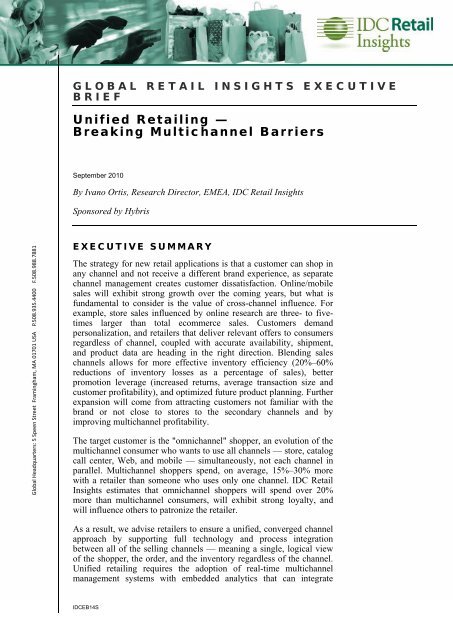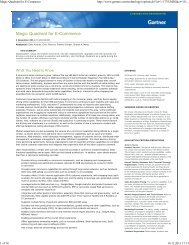Unified Retailing â Breaking Multichannel Barriers - Hybris
Unified Retailing â Breaking Multichannel Barriers - Hybris
Unified Retailing â Breaking Multichannel Barriers - Hybris
Create successful ePaper yourself
Turn your PDF publications into a flip-book with our unique Google optimized e-Paper software.
GLOBAL RETAIL INSIGHTS EXECUTIVE<br />
BRIEF<br />
<strong>Unified</strong> <strong>Retailing</strong> —<br />
<strong>Breaking</strong> <strong>Multichannel</strong> <strong>Barriers</strong><br />
September 2010<br />
By Ivano Ortis, Research Director, EMEA, IDC Retail Insights<br />
Sponsored by <strong>Hybris</strong><br />
Global Headquarters: 5 Speen Street Framingham, MA 01701 USA P.508.935.4400 F.508.988.7881<br />
EXECUTIVE SUMMARY<br />
The strategy for new retail applications is that a customer can shop in<br />
any channel and not receive a different brand experience, as separate<br />
channel management creates customer dissatisfaction. Online/mobile<br />
sales will exhibit strong growth over the coming years, but what is<br />
fundamental to consider is the value of cross-channel influence. For<br />
example, store sales influenced by online research are three- to fivetimes<br />
larger than total ecommerce sales. Customers demand<br />
personalization, and retailers that deliver relevant offers to consumers<br />
regardless of channel, coupled with accurate availability, shipment,<br />
and product data are heading in the right direction. Blending sales<br />
channels allows for more effective inventory efficiency (20%–60%<br />
reductions of inventory losses as a percentage of sales), better<br />
promotion leverage (increased returns, average transaction size and<br />
customer profitability), and optimized future product planning. Further<br />
expansion will come from attracting customers not familiar with the<br />
brand or not close to stores to the secondary channels and by<br />
improving multichannel profitability.<br />
The target customer is the "omnichannel" shopper, an evolution of the<br />
multichannel consumer who wants to use all channels — store, catalog<br />
call center, Web, and mobile — simultaneously, not each channel in<br />
parallel. <strong>Multichannel</strong> shoppers spend, on average, 15%–30% more<br />
with a retailer than someone who uses only one channel. IDC Retail<br />
Insights estimates that omnichannel shoppers will spend over 20%<br />
more than multichannel consumers, will exhibit strong loyalty, and<br />
will influence others to patronize the retailer.<br />
As a result, we advise retailers to ensure a unified, converged channel<br />
approach by supporting full technology and process integration<br />
between all of the selling channels — meaning a single, logical view<br />
of the shopper, the order, and the inventory regardless of the channel.<br />
<strong>Unified</strong> retailing requires the adoption of real-time multichannel<br />
management systems with embedded analytics that can integrate<br />
IDCEB14S
disparate customer selling front-end systems with back-end platforms<br />
(supply chain, merchandise management). Mobile will be a key<br />
enabler of unified retail consumer experiences. Retailers now have an<br />
opportunity to differentiate the customer experience by capturing the<br />
"first-mover advantage" as customers go mobile. We recommend that<br />
retailers define a three- to five-year strategic plan on mobile.<br />
From <strong>Multichannel</strong> Retail to <strong>Unified</strong><br />
<strong>Retailing</strong><br />
Why Should Retailers Break Down the <strong>Barriers</strong> Between<br />
Channels?<br />
The worldwide ecommerce market is becoming sizeable for<br />
multichannel retailers and keeps growing at a faster pace than offline<br />
sales, although the overall size of the ecommerce market remains<br />
smaller. In Europe, 37% of the total population shopped online in<br />
2009, up from 32% in 2008, with consumers in the U.K. and Germany<br />
leading the group. Globally, we expect online sales to grow by over<br />
20% in 2010, and by nearly 50% in 2010–2013.<br />
One of the most common, traditional measures of a retailer's health are<br />
same-store sales. Key measures of multichannel activity were<br />
traditionally new customer acquisition and sales growth. The focus<br />
now shifts to "same shopper" sales — using loyalty or payment<br />
identifiers to calculate how shoppers are patronizing the brand across<br />
stores and channels. For brick and mortar retailers, much of their<br />
secondary channel (catalog, Web, mobile) commerce is with<br />
consumers who are familiar with the brand and have likely shopped in<br />
their physical stores. Expansion will come from attracting customers<br />
not familiar with the brand or not close to stores to those secondary<br />
channels and by improving multichannel profitability.<br />
The target customer is the "omnichannel" shopper, an evolution of the<br />
multichannel consumer who wants to use all channels — store, catalog<br />
call center, Web, and mobile — simultaneously, not each channel in<br />
parallel. An example is the shopper with an Android-based phone or<br />
an iPhone who snaps a picture of the bar code of a product in the store<br />
and immediately does price comparisons on the Web as well as<br />
connecting to his/her social network for opinions. Perhaps one of those<br />
friends bought the product and doesn't use it and offers to give it to the<br />
friend. Can the retailer recognize this activity and at least offer<br />
accessories? Are there services attached to the product that can be<br />
offered?<br />
In addition, multichanel retailers should consider the following key<br />
facts:<br />
● Store sales influenced by online research are three- to five-times<br />
larger than total ecommerce sales. To illustrate my point, Terry<br />
Lundgren, chairman, president, and CEO of Macy's, said Macy's<br />
3.0, the latest rendition of the company's ecommerce platform,<br />
provides a 360 degree view of the customer and is responsible for<br />
Page 2 #IDCEB14S ©2010 IDC Retail Insights
$1 billion in sales this year and a $5+ billion influence on in-store<br />
sales improvement. Interestingly, Macy's CMO is now responsible<br />
for marketing across channels. Another example comes from<br />
consumer electronics retailers, where 10% to 15 % of in-store TV<br />
sales come from online promotions.<br />
● Online purchasing patterns are evolving: consumer research shows<br />
that online sales of clothes, accessories, and footwear have become<br />
increasingly popular. While travel, media and consumer<br />
electronics continue to represent a larger share of the total B2C<br />
ecommerce spending — it nonetheless signals the increasing<br />
maturity of online commerce across product and service<br />
categories.<br />
Business Benefits Resulting From <strong>Multichannel</strong> Retail IT<br />
Investments<br />
Potential business value resulting from full process and technology<br />
integration across channels includes:<br />
● 15%–35% increase in average transaction size.<br />
● 5%–10% increase in loyalty customers' profitability.<br />
● 30%–45% increase in online conversion rates, thanks to reduced<br />
Web site abandonment, recovery of lost sales and abandoned carts<br />
via guided selling.<br />
● 20%–60% reductions of inventory losses as a percentage of sales<br />
— multichannel capabilities can lead to inventory optimization, via<br />
a seamless integration of virtual and physical stores.<br />
● Improved customer service leveraging on instant online support<br />
and expert in-store support typically associated with rich media<br />
(video communication and collaborative tools).<br />
How to Drive a <strong>Unified</strong>, Converged<br />
Approach to Retail Channels?<br />
Drivers of retail cross-channel transparency will be the buying<br />
behavior of new consumers — "channel choice"; the need for<br />
complete inventory visibility; need for broader targeted marketing<br />
opportunities.<br />
We recommend multichannel retailers consider the following best<br />
practice approach:<br />
● Define a customer experience program based on the AISS model<br />
for your enterprise (Attract, Influence, Service and Support, see<br />
figure 1). Set measurable objectives around key customer metrics<br />
and business KPIs.<br />
● Ensure cross-channel transparency by supporting full technology<br />
and process integration between all of the selling channels —<br />
©2010 IDC Retail Insights #IDCEB14S Page 3
meaning a single, logical view of the shopper, the order, and the<br />
inventory regardless of the channel.<br />
● Consolidate cross-channel supply chain management — both<br />
planning and execution — allowing for total inventory visibility,<br />
order management, and fulfillment across all channels. Consolidate<br />
assortment planning across channels. Use inventory optimization<br />
tools and analytics to balance stock-levels and purchasing<br />
requirements regardless of channel. This means driving back-end<br />
modernization and integration for supporting multiple sales<br />
channels in a transparent fashion for the entire organization: key to<br />
ensuring multichannel profitability beyond new customer<br />
acquisition and sales growth objectives.<br />
● Start delivering initial cross-channel services and targeted<br />
promotions based on demography and customer segments (e.g.,<br />
click & collect, order in-store deliver home, online Web shopping<br />
list available on kiosks or mobile devices). The fun and surprise in<br />
shopping needs to be restored so that shoppers are less compelled<br />
by the lowest advertised prices and more by the emotion attached<br />
to a brand and the shopping experience. Cross-channel loyalty<br />
needs to improve.<br />
● Improve cross-channel CRM/loyalty capabilities based on realtime<br />
business decision support. Online consumers are indicating<br />
that the possibility of using the same loyalty program both online<br />
and offline is their second favorite feature for an ecommerce Web<br />
site to develop. In profit margin improvement terms for the<br />
retailer, we find that cross channel loyalty integration can drive<br />
10% increases in loyal customers' profitability. This is an<br />
important achievement if we consider that loyal clients are<br />
typically a high share of the total customer base in selected<br />
segments, such as food, with typically over 75% of customers<br />
holding a loyalty card, and consumer electronics, where for<br />
example Mediamarket in Italy have one million loyal clients that<br />
generate 70% of its total online sales. Retailers have the fear of<br />
seeing online loyalty as a way for customers to redeem points<br />
without generating the multiplication effect and impulse buying of<br />
new store visits. Thus retailers are looking into new ways of<br />
combining online loyalty with store visits, for example by offering<br />
online coupons that can be redeemed at the store. Mobile<br />
represents perhaps the best way to create the required continuum<br />
between online and store.<br />
● Online customer support is a key consumer expectation that can<br />
also result in 75% cost savings when moving call center to Webbased<br />
support. Retailers also noted a direct correlation among<br />
customer service enhancements and increases in average revenue<br />
per user. As a result, cross-channel customer service investments<br />
can pay off.<br />
● Deliver advanced multichannel services (e.g., start an order from<br />
any channel, complete it from any other channel). Integrate<br />
transactional channels (e.g., store, online, call center, catalogue)<br />
Page 4 #IDCEB14S ©2010 IDC Retail Insights
with relational channels (e.g., social media, mobile) to drive<br />
consumer influence and brand image.<br />
● Convert relational into transactional channels with full exploitation<br />
of the collaborative ecosystem and integration of search engine<br />
marketing (SEM) tools that allow instant sync with the inventory.<br />
Use social networking tools to empower customer intelligence and<br />
customer marketing, enable targeted promotions, assortment and<br />
new product developments. Customers' feedback can also be<br />
gathered flawlessly via social networks when integrated with CRM<br />
platforms. Using advanced analytics, retailers can now enable oneto-one<br />
relations and contextually-relevant real-time interactions<br />
with customers, while at the same time tracking shopping patterns<br />
and customer feedback and therefore monitoring business KPIs<br />
with more timeliness and accuracy. This again benefits the bottomline,<br />
thanks to top-line growth, lower stock levels, and better<br />
designed assortments that fit shoppers' expectations.<br />
FIGURE 1<br />
AISS Model for <strong>Multichannel</strong> Retail Strategies<br />
Attract<br />
Influence<br />
Service&<br />
Support<br />
Precision<br />
Marketing<br />
Merchandising<br />
Retail Demand<br />
Intelligence<br />
Cross-Channel Consumer Experience<br />
Customer<br />
Experience<br />
CRM & Loyalty Management<br />
Consumer<br />
touch-points<br />
Launching<br />
New Services<br />
Supply Chain<br />
Insight<br />
Information<br />
Search,<br />
Track<br />
Interaction<br />
Transaction<br />
Anticipate<br />
& Respond<br />
Shopping<br />
Lifecycle<br />
Manage<br />
Source: IDC Retail Insights, 2010<br />
©2010 IDC Retail Insights #IDCEB14S Page 5
<strong>Unified</strong> <strong>Retailing</strong> — Key IT Implications<br />
<strong>Unified</strong> retailing requires the adoption of real-time multichannel<br />
management systems with embedded order and fulfillment capabilities<br />
and middleware-based application integration features. In other words,<br />
the target architecture is to have centralized store systems fully<br />
integrated with ecommerce, mobile sales, and catalogue/call center<br />
sales on the front-end, as well as back-end integration with supply<br />
chain, merchandise management, and other enterprise systems.<br />
● Define a store-level integration framework based on SOA. The<br />
definition of single, highly cohesive store systems architecture<br />
across the many different technologies — including online — will<br />
result in the harmonized execution of every process across all<br />
customer touch points, private labels, and branded goods, as well<br />
as selling channels. This will also enable the ability to drive<br />
incremental rollouts of customer-facing technologies under a<br />
common, unified, and cost-optimized program.<br />
● Ensure tight integration to legacy retail transactional systems and<br />
all the appropriate consumer, promotion, and inventory<br />
optimization technologies. This integrated application landscape<br />
will allow retail executives to orchestrate inventory,<br />
merchandising, customer service, loyalty, marketing with<br />
embedded order management and analytics.<br />
● Social media requires investments in semantic/unstructured data<br />
search tools to deliver customer sentiment analysis and support.<br />
● Drive ecommerce modernization with Web 2.0 technologies such<br />
as AJAX, on-demand managed services, video and product-rich<br />
information capabilities to influence, guide, and enrich the<br />
shopping experience with a more engaging and interactive<br />
environment.<br />
● Ensure multichannel and ecommerce platform scalability,<br />
availability, and performance. Outsourced, service-oriented<br />
provisions of ecommerce platforms emerge as the most relevant<br />
sourcing option for retailers.<br />
● Safeguard data privacy and payment security.<br />
The Role of Mobile in <strong>Multichannel</strong> Retail<br />
Consumer research suggests that young, trend-setting consumers and<br />
high spenders will be the first demographics to move en masse to the<br />
mobile channel. Retailers are responding to this trend by improving<br />
their mobile interaction capabilities. In a 2010 survey of 150 U.S.<br />
retailers, we found that nearly three out of four (73%) retailers now<br />
have some type of mobile initiative in place, while 20% are in the<br />
process of evaluating the mobile channel. European retailers are<br />
unveiling a similar focus on mobile.<br />
Page 6 #IDCEB14S ©2010 IDC Retail Insights
Mobile can translate into several different opportunities for retailers.<br />
Setting the mobile strategy agenda right is crucial to creating a<br />
competitive advantage. Interestingly, consumers express stronger<br />
requirements around interacting rather than just transacting with<br />
retailers using their mobile device. For example, checking the status of<br />
an order, searching for store locations, opening hours and product<br />
availability and receiving alerts about promotions that are offered by<br />
stores nearby the shopper location rank highest. Google launched its<br />
mobile goggles app for Android, with which a user can simply frame a<br />
shop or location and receive contextual messages about the store,<br />
offers, user reviews, and the like. Similar applications are available on<br />
Android, iPhone, Symbian, and Windows mobile devices to retrieve<br />
product information, compare prices, and read user comments, via<br />
barcode scanning and image and voice recognition.<br />
Speed and readability are the major barriers to mobile commerce<br />
adoption. Retailers are also struggling with how to support a multitude<br />
of mobile platforms, screen sizes, input capabilities, and customer<br />
segments. Real-time data flows, data privacy, strong authentication<br />
and security are essential requirements to enable successful mobile<br />
deployments.<br />
While mobile use case scenarios, trials, and implementations are<br />
proliferating, the essential fact is that mobile consumer interaction<br />
blends payment, loyalty, customer service, and promotional offers to<br />
the next level. Unique in this shopping experience are:<br />
● Convenience — consumers are using their mobile phones or are<br />
interacting with engaging mobile technologies. It is most likely to<br />
be fun, easy, and highly accessible for customers. An all-digital<br />
wallet that could be used for payments, loyalty programs, and<br />
promotions could become a reality.<br />
● Immediate interaction — mobile is a live, ubiquitous, always-on,<br />
real-time interaction capability right in the hands of your<br />
customers. It gives consumers full control (or an increased<br />
perception of it) of their shopping experience, along with better instore<br />
assistance (for example, quicker access to inventory<br />
information to improve store staff effectiveness or mobile scanning<br />
for rich product information, reviews, and comparisons).<br />
● Relevance and personalization — perhaps the most distinguishing<br />
factor for today's consumers, hence the most differentiating<br />
opportunity for retailers. Mobile can enable instant customer<br />
identification and interaction, so that targeted promotions/loyalty<br />
and personalized communications are a natural choice. Adding<br />
relevancy into the picture — think of adaptable interactions<br />
depending on consumers' location, context, and lifestyle — can<br />
make the difference between "dressed" personalization and truly<br />
individualized service. Among the retailer benefits, personalized<br />
coupons via mobile phones are achieving average redemption rates<br />
of over 30%. Paper-based coupons today typically produce a<br />
0.5%–1% redemption rate.<br />
©2010 IDC Retail Insights #IDCEB14S Page 7
In conclusion, we find strong consensus about the fact that mobile is<br />
not just a third or fourth sales channel. Mobile is an enabler of the<br />
other channels as well and can increase basket size, conversions, and<br />
retention rates, while driving new customer acquisitions. Creating<br />
interaction among consumers' owned mobile devices, online<br />
commerce sites, digital signage and other in-store technologies, will<br />
therefore be a key success factor going forward.<br />
Copyright Notice<br />
The analyst opinion, analysis, and research results presented in this<br />
IDC Retail Insights Executive Brief are drawn directly from the more<br />
detailed studies published in IDC Retail Insights subscription services.<br />
Any IDC Retail Insights information that is to be used in advertising,<br />
press releases, or promotional materials requires prior written approval<br />
from IDC Retail Insights. Contact IDC Retail Insights at 508-935-<br />
4400 to request permission to quote or source IDC Retail Insights or<br />
for more information on IDC Retail Insights Executive Briefs. Visit<br />
www.idc-ri.com to learn more about IDC Retail Insights subscription,<br />
consulting, and Go-to-Market services.<br />
Copyright 2010 IDC Retail Insights. Reproduction is forbidden unless<br />
authorized.<br />
Page 8 #IDCEB14S ©2010 IDC Retail Insights





